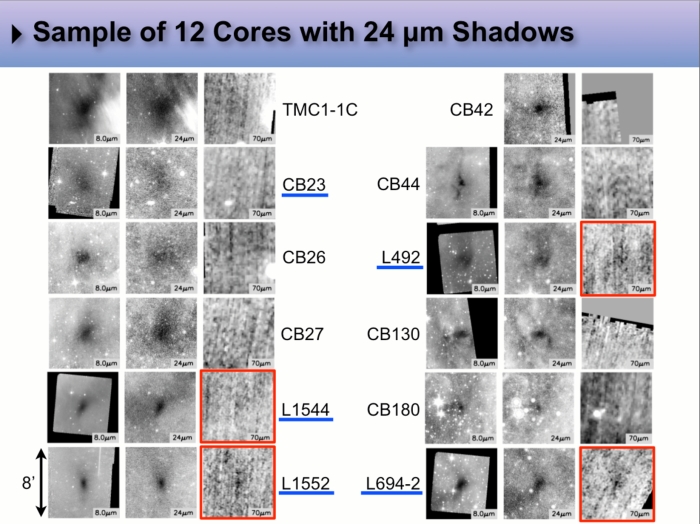| EPoS Contribution |
|
A Spitzer study of dense cores: constraining the earliest stages of
low mass star formation
Amelia M. Stutz Max-Planck-Institut für Astronomie, Heidelberg, Germany | |
| The identification and detailed characterization of truly pre-stellar cores -- cores that are forming or will soon form stars -- is hindered by observational limitations at long wavelengths. These difficulties can be partially overcome by observing nearby, isolated star-forming regions. Further advances can be made by observing the shadows cast by these cores at Spitzer wavelenghts. I present a sample of 14 starless cores observed with Spitzer/MIPS; analogous to IRDCs, our sample of starless cores were selected be viewed in absorption at 8 um, 24 um, and sometimes 70 um. The observed absorption features, or shadows, are cast by the most embedded and dense core material at the heart of the clouds. Using these a simple Jeans mass criterion we find that ~ 2/3 of the cores selected to have prominent 24 micron shadows are collapsing or near collapse, a result that is supported by millimeter line observations. Of this subset at least half have indications of 70 micron shadows. All cores observed to produce absorption features at 70 micron are close to collapse. We conclude that 24 micron shadows, and even more so the 70 micron ones, are useful markers of cloud cores that are approaching collapse. We place detailed observational constraints on starless core masses, sizes, and geometries. | |
 | |
| Caption: 8'x 8' Spitzer images of 12 starless cores, shown at 8, 24, and 70 um. Core with indications of 70 um shadows are highlighted with red boxes; cores with indications of a blue asymmetry in their line profiles are underlined in blue. Analysis of the 24 um absorption features, or shadows, reveals that ~2/3 of cores with 24 um shadows are collapsing or near collapse, and that 100% of cores with 70 um absorption features are close to collapse. The shadows allow for detailed observational constraints on starless core masses, sizes, and geometries. | |
| Collaborators: G. Rieke, Steward Obs., USA J. Bieging, Steward Obs., USA F. Heitsch, UNC Chapel Hill, USA Y. Shirley, Steward Obs., USA |
Key publication
Suggested Session: Cores and Collapse, Herschel |

